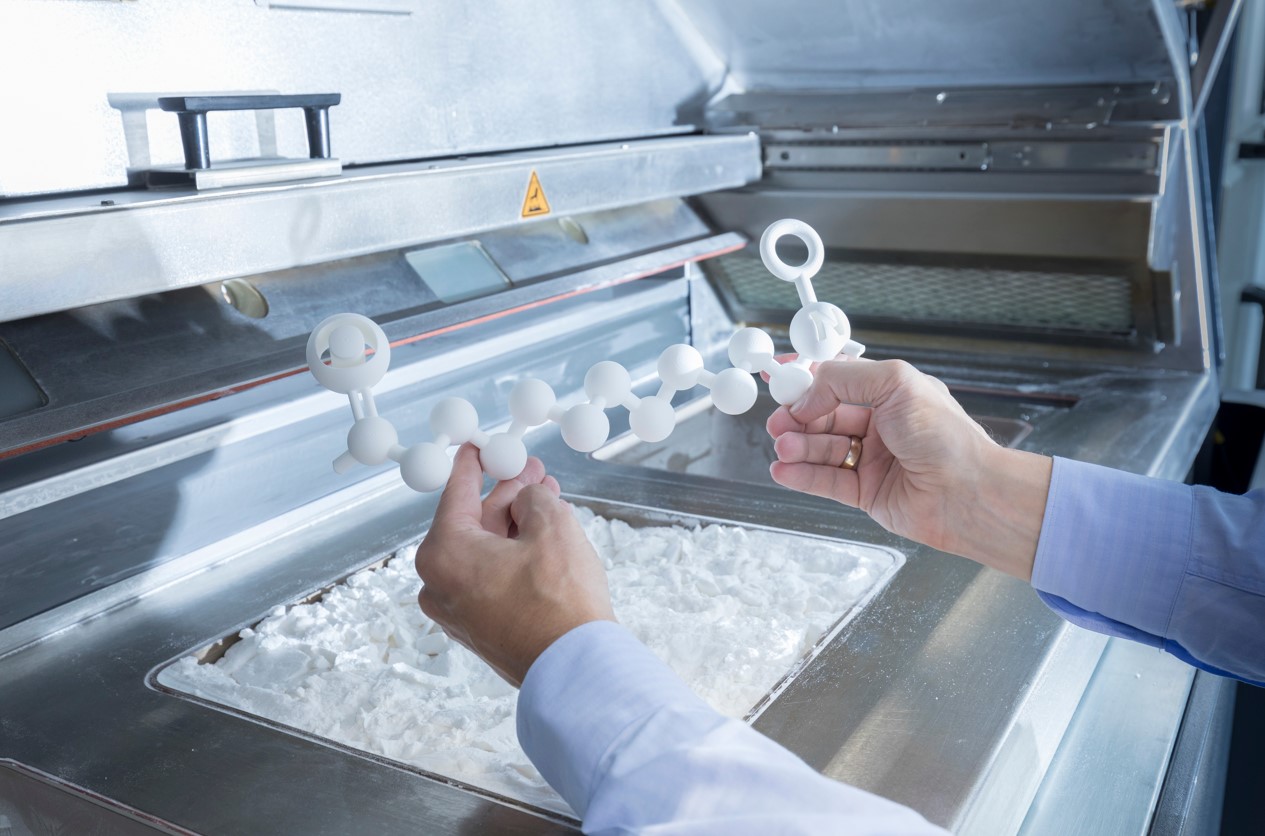We have grown up in an environment where plastic, once used, is considered waste. This burden has prevented generations of consumers and industries from capturing the economic benefits of plastic. With Additive Manufacturing and circular economy at the top of Europe’s agenda, waste that was considered a burden before has now turned into gold. The only thing is that it’s up to each company to find the right way to make it glitter. We asked difficult questions to Evonik’s Dominic Störkle to understand their strategy.
Why specialty chemicals company Evonik, you may ask? Because I strongly believe that a circular economy strategy for 3D printed plastics starts with material. More importantly, material producers have the right expertise and can leverage the right resources to put in place a circular economy or a system that avoids waste and limits resource consumption by recirculating existing materials. Such circularity would mean recapturing and reusing existing polymers when and where possible, as well as controlling or restricting the development of new, virgin materials made from non-renewable fossil fuels.
To do so, material producers have to understand the specific market they operate in. Indeed, each material producer will have unique objectives when it comes to circular economy.
The article below aims to help you understand:
- The specifications and the challenges for a material producer operating in the AM industry
- The decisions made at the manufacturing level to produce 3D printing materials with circular economy in mind
- Where Evonik is in its sustainability journey
The specifications and the challenges for a material producer operating in the AM industry
The mindset around plastic waste pollution is usually one of the first barriers to companies dealing with plastics. Interestingly, this mindset is not really the problem in the AM industry because the technology itself has cultivated an attitude towards recycling materials. One of the first challenges, according to Evonik will be to determine how to materialise this know-how.

“There are good examples already of well-working recycling concepts like in the case of PET bottles. In the next step which is already ongoing, we have to transfer this know-how to other application areas in order to circulate high volumes and thus improve the economics of plastic recycling. The plastics industry understands the need to force innovation in mechanical recycling but also in chemical recycling technologies,” Dominic Störkle, Head of Additive Manufacturing Innovation Growth Field at Evonik explains from the outset.
Despite this good attitude from the AM industry, recycling rates remain small across industries in general. In Europe for instance, which tends to take the lead on environmental issues, the recycling rate is about 32.5 wt%* (Plastics, 2019) in general. To increase this recycling rate, Störkle calls on legislation:
“Legislation will play an important role in driving circular plastics economy like, for instance, the EU’s directive on end-of-life vehicles, which will trigger significant demand for recycled materials from the industry. In this regard, EU legislation on recycled content target in automotive is looking at 25% recycled content in the near future. This target is also supported by the Plastics Europe Association.
Driving circularity for special polymers such as polyamide 12 requires close collaboration across the entire value chain to find out the right concepts. As a market leader for PA12 materials, we are at the right point of contact for key market players to get this started.”
That being said, one needs to recognize that improving global recycling rates can also be challenging because of poorly functioning markets. Indeed, the raw feedstocks for most plastics remain fossil fuels, which are currently cheaper to use than recycled materials. The question then, is to know how far you are willing to go to propose an alternative that is more environment-friendly.
Answering this question will help AM users understand the decisions you made at the manufacturing level to produce materials.
Producing 3D printing materials with circular economy in mind

Traditionally, the philosophy of the circular economy has been structured around the 3Rs: reduce, reuse, and recycle. As someone who is well familiar with organizations providing ESG services, I know it’s more than that because each company tackling this topic defines its own terminology. Evonik is no exception.
“In our terminology, reusability of materials refers to the refresh rates over several printing cycles, defined by the replacement of just the powder that was used to form the part created during the previous job. In this regard, our PA12 grades exhibit the market’s best reusability rates while evidencing high surface quality and stable mechanical properties of 3D printed parts over several printing cycles. When it comes to recycling, 3D printing is a great technology because it enables a toolless design for recycling of highly complex parts and structures that are manufactured next using only one type of material. These practices help bring end-of-life parts into a second life cycle, creating an optimized closed-loop ecosystem,” the Head of AM explains.
So, how do we define a strategy that aims to reduce plastic waste and greenhouse gas emissions in the plastic value chain while delivering market returns?
That’s a tough question even for the most experienced experts – because of the versatile use of plastics. Some of us may use 3D printing plastic materials for implants that enhance the quality of life of millions of patients worldwide, while others leverage them for high-performance applications in the automotive industry. And these materials will continue improving so many aspects of our lives in the future.
“That’s why today’s shift from a linear to a circular plastics economy is crucial to safeguarding the quality of life for next generations,” Störkle adds, before attempting to respond to the question: “Establishing an efficient circular economy, however, is a complex thing: every single step in the production cycle must be re-evaluated, supply chains must be reorganized, sustainable materials like our footprint reduced PA12 with a high reusability rate are needed and eventually new way of parts design is necessary. For material producers like Evonik, living circularity might not be so self-evident for everyone. However, the more aware and transparent the sustainable journey becomes at the beginning of the additive value chain, the more impact these effects will have in the final application. Yet material manufacturers bear a great responsibility here because the sustainable result of an application stands or falls with the sustainable performance of the materials used.”
In this vein, Störkle agreed with us: moving away from fossil resources is a must and this can be done in several ways. For Evonik, this means acknowledging the importance of biobased raw materials in sustainable manufacturing.
“An unreflected use of biobased raw materials as a more sustainable choice for so-called eco-friendly manufacturing is changing at the moment. Fact-based decisions should be made. There are other biobased raw material alternatives available on the market today like bio-circular oils or rapeseed oil grown in closer proximity to our production site. Transparency is key,” the expert points out.
More than cutting CO2 emissions, it’s about determining “a holistic analysis that includes other important factors, such as water consumption or land use along improved overall eco-balances. Evonik drives the circular plastics economy by contributing to both footprint and handprint values. Alongside factors such as production efficiency or the reusability of materials, our circularity approach includes the total life cycle assessments of our materials and their consistent improvement. We look not only at carbon footprint as well as other important factors such as water consumption and land use. Through the use of renewable energy sources and renewable or recycled feedstocks for production, we are significantly improving the overall eco-balance of our materials. Looking ahead, we are working on end-of-life opportunities for our polymers,” he adds.
Where is the company headed?
 As the first tangible and publicly announced step to back words with action in the AM industry, Evonik introduced a new grade of PA12 powders with significantly reduced CO2 emissions. We caught up with the company at Formnext 2022 to learn more about the cornerstones of their sustainable manufacturing approach (carbon footprint, saving fossil resources, reusability rate and recycling). While other releases have marked this year, we were keen to discover what specific progress has been made in their sustainability journey. Störkle’s response did not disappoint:
As the first tangible and publicly announced step to back words with action in the AM industry, Evonik introduced a new grade of PA12 powders with significantly reduced CO2 emissions. We caught up with the company at Formnext 2022 to learn more about the cornerstones of their sustainable manufacturing approach (carbon footprint, saving fossil resources, reusability rate and recycling). While other releases have marked this year, we were keen to discover what specific progress has been made in their sustainability journey. Störkle’s response did not disappoint:
“Since introducing our carbon-footprint-reduced PA12 materials for powder bed fusion 3D printing technologies last year, we have been developing an eCO grade of our nylon powders that is aligned with Evonik’s mass-balanced approach. At this year’s Formnext trade show, we will be launching a new PA12 grade that exhibits the highest circular benefits available on the market for additive manufacturing today.
The product will be called INFINAM® eCO, and it will be the world’s first PA12 powder material for 3D printing that substitutes 100 percent of fossil feedstock with bio-circular raw material from waste cooking oil in a mass balancing process. By using 100 percent renewable energy for production, the new ready-to-use PA12 powder features a carbon footprint reduction of 74% – in comparison to our castor seed oil-based INFINAM® Terra grade. Furthermore, INFINAM® eCO will offer the market’s best reusability rate to eliminate production waste even further. It can be reused over several cycles by only replacing the powder needed to form the part created during the previous job.”
What’s next, you might wonder?
The growing need for environmentally friendly manufacturing has emphasized the need for assessments like LCAs that demonstrate the environmental impact of one’s technology. Evonik is aware of that and strongly believes that true circularity leads to a successful business.
“As a pioneer for polymer-based 3D printing materials, we will follow our formula for our PA12 powders to drive circular plastics economy in additive manufacturing by improving the efficiency of our production processes and the overall improved of eco-balances of our materials,” Störkle comments.
As the company is currently exploring new end-of-life opportunities for its polyamide 12 powders, we hope to share their progress in the next edition of 3D ADEPT Mag which focuses on sustainability.
“We are always on the lookout for companies to collaborate with in the field of additive manufacturing in order to establish material collection schemes and promote the reuse of polymers,” Störkle concludes.
This content has been produced in collaboration with Evonik. It has initially been produced in the September/October edition of 3D ADEPT Mag.


